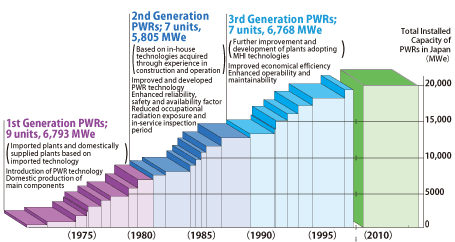| 1970 |
Mihama-1 |
- Commence commercial operation on November 28 1970
- 1st PWR in Japan(2-loop plant)
- Pressurizer manufactured domestically
- Turbine / generator manufactured domestically(with steam reheating system)
|
|---|
| 1972 |
Mihama-2 |
- Commence commercial operation on July 25 1972
- 1st PWR supplied by Mitsubishi as a main contractor
- Steam generator manufactured domestically
- Reactor vessel manufactured domestically
|
|---|
| 1974 |
Takahama-1 |
- Commence commercial operation on November 14 1974
- 1st 3-loop plant in Japan
- Turbine EH Governor
- Feed water treatment changed to AVT(All Volatile Treatment with hydrazine)
|
|---|
| 1975 |
Genkai-1 |
- Commence commercial operation on October 15 1975
- Core Internals manufactured domestically
- Control Rod Drive Mechanism manufactured domestically
|
|---|
| Takahama-2 |
- Commence commercial operation on November 14 1975
|
| 1976 |
Genkai-1 |
- High-purity feed water treatment by Condensate Demineralizer
|
|---|
| Mihama-3 |
- Commence commercial operation on December 1 1976
- Pre-fabricated piping systems
|
| 1977 |
Ikata-1 |
- Commence commercial operation on September 3 1977
- 44-inch high-efficiency turbine blades
|
|---|
| 1979 |
Ohi-1 |
- Commence commercial operation on March 27 1979
- 1st 4-loop PWR in Japan
- 17×17 fuel assemblies
- Two-stage reheat turbine system
- Ice condenser type reactor containment
- Water-cooled generator stator coils
|
|---|
| Ohi-2 |
- Commence commercial operation on December 5 1979
|
| 1981 |
Genkai-2 |
- Commence commercial operation on March 30 1981
- Reactor coolant pump manufactured domestically
- Up-flow design of core internals
|
|---|
| 1982 |
Ikata-2 |
- Commence commercial operation on March 19 1982
|
|---|
| 1984 |
Sendai-1 |
- Commence commercial operation on July 4 1984
- 1st application of MITI improvement/standardization program
- Titanium tube condenser
- Integrated reactor vessel head
- Super-size moisture separator reheater
|
|---|
| 1985 |
Takahama-3 |
- Commence commercial operation on January 17 1985
- Advanced reactor coolant pump
- Thick-steel-plate reactor containment
- Mono-block low-pressure turbine rotor
- Compatible with house load operation
|
|---|
| Takahama-4 |
- Commence commercial operation on June 5 1985
|
| Sendai-2 |
- Commence commercial operation on November 28 1985
|
| 1987 |
Tsuruga-2 |
- Commence commercial operation on February 17 1987
- PCCV(pre-stressed concrete containment vessel)
- Forged ring reactor vessel core region
|
|---|
| 1989 |
Tomari-1 |
- Commence commercial operation on June 22 1989
- 1st Japanese PWR for 50Hz service
- Domestic supply of reactor coolant pumps for 50Hz service
|
|---|
| 1991 |
Tomari-2 |
- Commence commercial operation on April 12 1991
- Digital control system
- Advanced control board
- Generator load-break switch
|
|---|
| Ohi-3 |
- Commence commercial operation on December 18 1991
|
| 1993 |
Ohi-4 |
- Commence commercial operation on February 2 1993
|
|---|
| 1994 |
Genkai-3 |
- Commence commercial operation on March 18 1994
|
|---|
| Ikata-3 |
- Commence commercial operation on December 15 1994
- 52-inch low pressure turbine blades
|
| 1997 |
Genkai-4 |
- Commence commercial operation on July 25 1997
|
|---|
| 2009 |
Tomari-3 |
- Commence commercial operation on December 22 2009
- 54-inch low pressure turbine blades
- Advanced control board design
- Completely digitalized control/protection system
|
|---|



